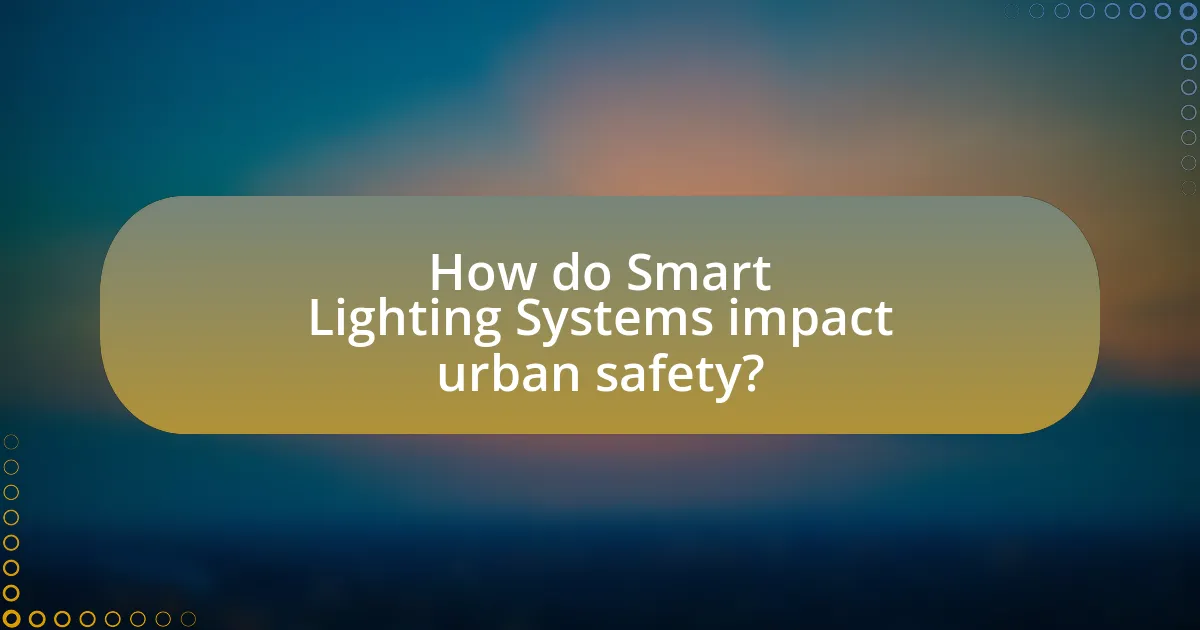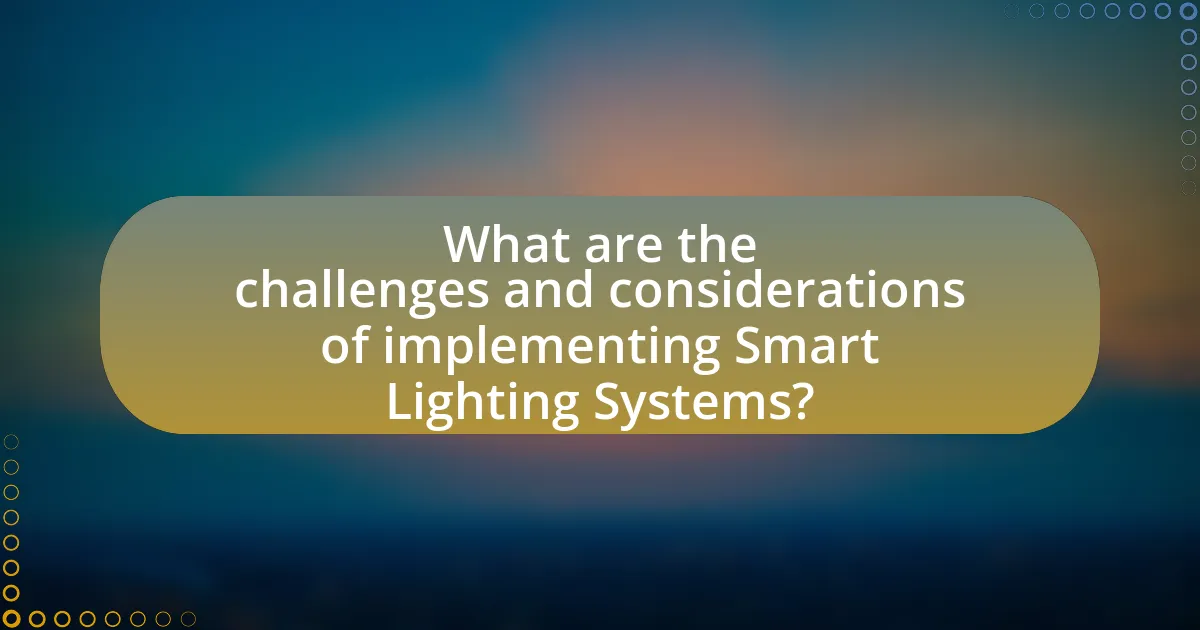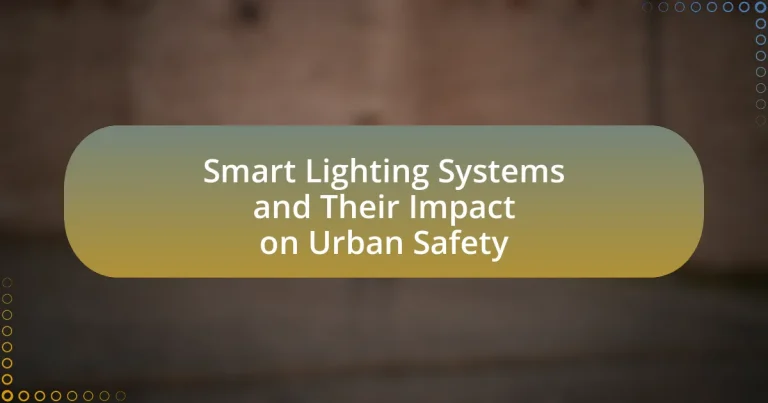Smart lighting systems are advanced technological solutions designed to enhance energy efficiency and urban safety through adaptive lighting controls, sensors, and automation. These systems function by adjusting illumination based on real-time environmental conditions, such as occupancy and ambient light levels, significantly reducing energy consumption and improving visibility in public spaces. The article explores the integration of smart lighting with urban infrastructure, its impact on crime prevention, and the role of automation and data analytics in enhancing emergency response. Additionally, it addresses the challenges of implementation, including costs and privacy concerns, while highlighting best practices for cities to maximize the benefits of smart lighting systems in promoting safety and sustainability.

What are Smart Lighting Systems?
Smart lighting systems are advanced lighting solutions that utilize technology to enhance energy efficiency, user control, and adaptability in various environments. These systems often incorporate sensors, connectivity features, and automation to adjust lighting based on occupancy, time of day, or ambient light levels. For instance, a study by the International Energy Agency indicates that smart lighting can reduce energy consumption by up to 50% compared to traditional lighting systems, demonstrating their effectiveness in promoting sustainability and reducing operational costs.
How do Smart Lighting Systems function?
Smart lighting systems function by utilizing sensors, connectivity, and automation to control lighting based on environmental conditions and user preferences. These systems often incorporate technologies such as motion sensors, ambient light sensors, and smart controls that allow for real-time adjustments to brightness and color temperature. For instance, when a motion sensor detects movement, the system can automatically turn on lights, enhancing visibility and safety in urban areas. Additionally, smart lighting can be integrated with smart city infrastructure, allowing for centralized control and data collection, which can lead to energy savings and improved public safety. Studies have shown that well-lit environments can reduce crime rates, as illuminated areas are less attractive to potential offenders.
What technologies are integrated into Smart Lighting Systems?
Smart Lighting Systems integrate various technologies including LED lighting, wireless communication protocols, sensors, and smart controls. LED lighting provides energy efficiency and longevity, while wireless communication protocols such as Zigbee, Wi-Fi, and Bluetooth enable remote management and connectivity. Sensors, including motion and ambient light sensors, allow for adaptive lighting based on real-time conditions. Smart controls facilitate automation and integration with other smart city infrastructure, enhancing urban safety through improved visibility and responsiveness to environmental changes.
How do sensors enhance the functionality of Smart Lighting Systems?
Sensors enhance the functionality of Smart Lighting Systems by enabling adaptive lighting based on real-time environmental conditions and user presence. These sensors, such as motion detectors and ambient light sensors, allow the system to automatically adjust brightness levels, ensuring optimal illumination while conserving energy. For instance, a study by the International Energy Agency found that smart lighting systems equipped with sensors can reduce energy consumption by up to 30% compared to traditional lighting. Additionally, sensors improve safety by increasing light intensity in response to detected movement, thereby deterring crime and enhancing visibility in urban areas.
What are the key features of Smart Lighting Systems?
Smart lighting systems are characterized by their ability to adjust brightness, color, and energy consumption based on real-time data and user preferences. These systems utilize sensors, such as motion detectors and ambient light sensors, to optimize lighting conditions, thereby enhancing energy efficiency and user comfort. Additionally, smart lighting can be integrated with smart city infrastructure, allowing for remote control and monitoring through mobile applications or centralized management systems. This integration supports features like scheduling, dimming, and automated responses to environmental changes, contributing to improved urban safety by ensuring well-lit public spaces during critical times.
How does automation play a role in Smart Lighting Systems?
Automation is integral to Smart Lighting Systems as it enables dynamic control of lighting based on real-time data and user preferences. This technology allows for features such as adaptive brightness, which adjusts lighting levels according to ambient light conditions, enhancing energy efficiency and safety. For instance, studies show that automated systems can reduce energy consumption by up to 30% by optimizing light usage based on occupancy and time of day. Additionally, automation facilitates remote management and monitoring, allowing city planners to respond quickly to changing conditions, thereby improving urban safety through timely illumination in high-traffic areas or during emergencies.
What types of control options are available for Smart Lighting Systems?
Smart lighting systems offer several control options, including manual control, remote control via smartphone apps, voice control through smart assistants, and automated control using sensors and timers. Manual control allows users to operate lights directly, while remote control provides convenience through mobile applications, enabling users to adjust settings from anywhere. Voice control integrates with smart home devices, allowing users to command lighting through spoken instructions. Automated control utilizes motion sensors, ambient light sensors, and timers to adjust lighting based on environmental conditions or user schedules, enhancing energy efficiency and safety in urban environments.

How do Smart Lighting Systems impact urban safety?
Smart lighting systems enhance urban safety by improving visibility in public spaces, which deters criminal activity. Studies indicate that well-lit areas experience a significant reduction in crime rates; for instance, a report by the Urban Institute found that street lighting improvements led to a 20% decrease in crime in certain neighborhoods. Additionally, smart lighting can adapt to real-time conditions, such as increasing brightness when pedestrians are detected, further enhancing safety. This dynamic response not only fosters a sense of security among residents but also encourages more foot traffic, contributing to a safer urban environment overall.
What role does lighting play in crime prevention?
Lighting plays a crucial role in crime prevention by enhancing visibility and deterring criminal activity. Well-lit areas reduce the likelihood of crime, as potential offenders are less inclined to commit acts in environments where they can be easily seen. Research indicates that improved street lighting can lead to a significant decrease in crime rates; for instance, a study conducted in New York City found that the installation of brighter street lights resulted in a 20% reduction in crime in those areas. This correlation between lighting and safety underscores the importance of effective lighting strategies in urban planning and crime prevention initiatives.
How can improved visibility reduce crime rates?
Improved visibility can reduce crime rates by deterring potential offenders who prefer to operate in darkness. Enhanced lighting in public spaces, such as streets and parks, increases the likelihood that criminal activities will be observed by passersby or surveillance systems. A study conducted by the University of Chicago found that the installation of smart lighting systems led to a 21% reduction in crime in areas where visibility was significantly improved. This correlation suggests that better-lit environments create a sense of safety for residents and increase the perceived risk of apprehension for criminals, thereby lowering crime rates.
What evidence supports the link between lighting and safety?
Research indicates that improved lighting significantly enhances safety in urban environments. A study conducted by the University of California, Berkeley, found that increased street lighting led to a 20% reduction in crime rates in well-lit areas compared to poorly lit ones. Additionally, the National Institute of Justice reported that better lighting in public spaces decreases the likelihood of accidents and enhances pedestrian safety, as visibility is crucial for both crime prevention and accident reduction. These findings underscore the direct correlation between effective lighting and enhanced safety outcomes in urban settings.
How do Smart Lighting Systems enhance emergency response?
Smart lighting systems enhance emergency response by providing real-time illumination and data integration that improves situational awareness for first responders. These systems can automatically adjust brightness levels and focus on specific areas during emergencies, allowing for better visibility and navigation. For instance, a study by the National Institute of Standards and Technology found that smart lighting can reduce response times by up to 20% in urban environments by guiding emergency vehicles to the scene more efficiently. Additionally, smart lighting systems can be integrated with emergency management systems to relay critical information, such as the location of incidents, directly to responders, further enhancing their ability to react swiftly and effectively.
What features assist first responders in emergencies?
Smart lighting systems assist first responders in emergencies by providing enhanced visibility, real-time data, and improved communication. These systems utilize adaptive lighting that adjusts based on the situation, ensuring that areas are well-lit during critical incidents. For instance, smart lighting can automatically brighten in response to emergency vehicle presence, facilitating quicker access to the scene. Additionally, these systems can integrate with emergency response networks, offering real-time information about traffic conditions and hazards, which aids in route planning and situational awareness. Studies have shown that well-lit environments can reduce response times by up to 30%, demonstrating the effectiveness of smart lighting in enhancing urban safety for first responders.
How can real-time data from Smart Lighting Systems aid in crisis situations?
Real-time data from Smart Lighting Systems can significantly aid in crisis situations by providing immediate situational awareness and enhancing emergency response efforts. These systems can detect unusual activity or changes in the environment, such as increased foot traffic or the presence of emergency vehicles, and relay this information to local authorities in real-time. For instance, during a natural disaster, smart lighting can adjust brightness levels to guide evacuees safely or illuminate critical areas for first responders. Studies have shown that cities utilizing smart lighting technology have reported improved response times and better coordination among emergency services, demonstrating the effectiveness of these systems in enhancing urban safety during crises.

What are the challenges and considerations of implementing Smart Lighting Systems?
Implementing Smart Lighting Systems presents challenges such as high initial costs, integration with existing infrastructure, and data privacy concerns. High initial costs can deter municipalities from adopting these systems, as they require significant investment in technology and installation. Integration with existing infrastructure poses technical difficulties, as older systems may not be compatible with new smart technologies, leading to potential disruptions during the transition. Data privacy concerns arise from the collection and analysis of user data, necessitating robust security measures to protect sensitive information. These challenges must be addressed to ensure successful implementation and maximize the benefits of Smart Lighting Systems in enhancing urban safety.
What are the potential drawbacks of Smart Lighting Systems?
Smart lighting systems can lead to several potential drawbacks, including high initial costs, reliance on technology, and privacy concerns. The installation of smart lighting often requires significant investment in both hardware and software, which can be a barrier for municipalities or homeowners. Additionally, these systems depend heavily on technology, making them vulnerable to malfunctions or cyberattacks, which can compromise their effectiveness. Privacy issues arise as smart lighting systems often collect data on user behavior and patterns, raising concerns about surveillance and data security. These drawbacks highlight the need for careful consideration when implementing smart lighting solutions in urban environments.
How do costs affect the adoption of Smart Lighting Systems?
Costs significantly influence the adoption of Smart Lighting Systems by determining the initial investment and ongoing operational expenses. High upfront costs can deter municipalities and businesses from implementing these systems, as they may prioritize budget constraints over technological advancements. For instance, a study by the International Energy Agency found that the initial cost of smart lighting can be 30-50% higher than traditional lighting solutions, which can lead to hesitance in adoption despite potential long-term savings on energy and maintenance. Additionally, ongoing costs related to maintenance, software updates, and connectivity can further impact decision-making, as stakeholders weigh these against the anticipated benefits of improved urban safety and energy efficiency.
What privacy concerns arise with Smart Lighting Systems?
Smart lighting systems raise significant privacy concerns primarily due to their data collection capabilities. These systems often gather information about user behavior, location, and patterns of activity, which can be exploited if not properly secured. For instance, smart lighting can track when individuals are home or away, potentially making them targets for burglary. Additionally, the integration of cameras and sensors in some smart lighting systems can lead to unauthorized surveillance, infringing on personal privacy. Reports indicate that 70% of consumers express concerns about how their data is used by smart home devices, highlighting the need for stringent data protection measures.
How can cities effectively implement Smart Lighting Systems?
Cities can effectively implement Smart Lighting Systems by integrating advanced technologies such as sensors, IoT connectivity, and data analytics to optimize energy use and enhance public safety. These systems can automatically adjust lighting based on real-time conditions, such as pedestrian movement or ambient light levels, which has been shown to reduce energy consumption by up to 50% in some implementations. Additionally, cities can leverage data collected from these systems to identify high-crime areas and improve lighting in those locations, contributing to a decrease in crime rates; for instance, a study in Los Angeles found that improved street lighting led to a 10% reduction in crime. By collaborating with technology providers and engaging the community in the planning process, cities can ensure that Smart Lighting Systems meet the specific needs of their residents while maximizing safety and efficiency.
What best practices should be followed during installation?
Best practices during the installation of smart lighting systems include conducting a thorough site assessment, ensuring compliance with local regulations, and selecting appropriate technology based on environmental conditions. A site assessment identifies optimal locations for lighting fixtures to maximize coverage and minimize light pollution. Compliance with local regulations ensures that installations meet safety and zoning requirements, which is crucial for urban safety. Additionally, choosing technology that withstands local weather conditions, such as humidity or temperature extremes, enhances the longevity and effectiveness of the lighting system. These practices are supported by industry standards that emphasize safety, efficiency, and sustainability in urban lighting projects.
How can community engagement improve the success of Smart Lighting Systems?
Community engagement can significantly enhance the success of Smart Lighting Systems by fostering user acceptance and ensuring the systems meet local needs. When communities are involved in the planning and implementation phases, they can provide valuable insights into specific safety concerns and preferences, leading to tailored solutions that increase effectiveness. For instance, a study by the National Institute of Justice found that community input in urban design projects, including lighting, resulted in a 30% increase in perceived safety among residents. This collaborative approach not only improves the functionality of Smart Lighting Systems but also encourages community ownership, leading to better maintenance and utilization of the technology.
What are the future trends in Smart Lighting Systems and urban safety?
Future trends in Smart Lighting Systems and urban safety include the integration of IoT technology, adaptive lighting, and data analytics. Smart lighting systems will increasingly utilize sensors and connectivity to adjust illumination based on real-time conditions, enhancing visibility in high-crime areas and improving overall urban safety. For instance, cities like Barcelona have implemented smart streetlights that adjust brightness based on pedestrian presence, which has been shown to reduce crime rates by up to 30%. Additionally, the use of data analytics will enable cities to monitor crime patterns and optimize lighting placement, further contributing to safer urban environments.
How will advancements in technology shape Smart Lighting Systems?
Advancements in technology will significantly enhance Smart Lighting Systems by integrating IoT, AI, and energy-efficient solutions. These technologies enable real-time data collection and analysis, allowing for adaptive lighting that responds to environmental conditions and human presence. For instance, IoT sensors can adjust brightness based on pedestrian traffic, improving safety and energy efficiency. Additionally, AI algorithms can predict lighting needs based on historical data, optimizing energy consumption and reducing costs. The global smart lighting market is projected to reach $75 billion by 2025, indicating a strong trend towards these technological integrations.
What role will Smart Lighting Systems play in smart city initiatives?
Smart Lighting Systems will play a crucial role in smart city initiatives by enhancing urban safety and efficiency. These systems utilize advanced technologies such as sensors and IoT connectivity to optimize lighting based on real-time conditions, thereby improving visibility in public spaces and reducing crime rates. For instance, studies have shown that well-lit areas can decrease crime by up to 20%, as illuminated environments deter criminal activity. Additionally, Smart Lighting Systems contribute to energy savings by adjusting brightness according to pedestrian and vehicular traffic, which can lead to a reduction in energy consumption by approximately 30%. This integration of smart lighting not only fosters a safer urban environment but also supports sustainability goals within smart city frameworks.
What practical tips can cities follow to maximize the benefits of Smart Lighting Systems?
Cities can maximize the benefits of Smart Lighting Systems by implementing adaptive lighting controls that adjust brightness based on real-time conditions. This approach not only enhances energy efficiency but also improves safety by ensuring well-lit areas during peak activity times. For instance, studies show that adaptive lighting can reduce energy consumption by up to 50%, as demonstrated in cities like Los Angeles, which reported significant savings after upgrading to smart lighting. Additionally, integrating smart sensors that detect pedestrian movement can further enhance safety by increasing light intensity in response to foot traffic, thereby deterring crime and improving visibility.


